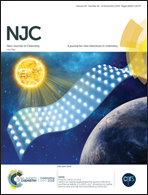Electronic transport properties in the stable phase of a cumulene/B7/cumulene molecular bridge investigated using density functional theory and a tight-binding method
Abstract
In this study, we first obtain the single-band tight-binding parameters of a B7 cluster in terms of matching the HOMO–LUMO levels obtained from density functional theory (DFT). Next, with the help of these parameters, we investigate the electronic and transport properties in the system formed by the B7 cluster connected to two cumulene chains as source and drain leads. Our quantum transport calculations are based on the Green's function method. Furthermore, by using frequency calculations, we study the stable phase among different configurations for connecting the B7 molecule to cumulene leads. Moreover, we obtain the absorption and emission gaps for the B7 molecule of 1.77 and 1.18 eV, respectively. In the presence of an electric field, a metal–semiconductor phase transition occurs in the system. We can control the transport properties of the molecular system by tuning parameters such as gate voltage and electric field. Because the LUMO orbital of the B7 molecule has lower energy levels, it is a good option for nanoelectronic devices.



 Please wait while we load your content...
Please wait while we load your content...